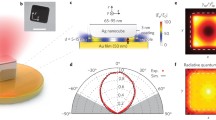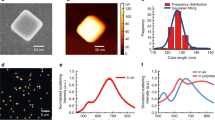Abstract
A full control of the interaction between confined plasmons and point sources of radiation is a central issue in molecular plasmonics. In this paper, a theoretical contribution towards a physical understanding on the localized surface plasmons excited into metallic nanocones by a point dipole is given. A numerical approach based on the discrete dipole approximation is applied to determine the modifications of the dipole decay rates for varying geometrical parameters of the dipole-metal nanoparticle system. Results declare the centrality of the cone aperture to control the plasmon resonances and to handle the effects it induces on the lifetime of a point emitter. A full spectral tuning of the resonances in the decay rates can be achieved by operating on a unique spatial degree of freedom: by tailoring the aperture alone, total decay rates 105 times higher than the free-space value can be obtained at short distances from the metal in a large region of the spectral range. Quite unexpectedly, size dependence of the antenna is found to have a marginal role if only a lifetime manipulation is desired. It becomes, instead, a crucial aspect of the problem when large quantum yields are required. Results presented in this work shed light on spontaneous emission modification due to interaction with plasmonic nanocones of different shapes and are relevant for a number of applications in the fields of nanoplasmonics and fluorescence microscopy.






Similar content being viewed by others
References
Bharadwaj P, Deutsch B, Novotny L (2009) Optical antennas. Adv Opt Photon 1:438
Kühn S, Hakanson U, Rogobete L, Sandoghdar V (2006) Enhancement of single-molecule fluorescence using a gold nanoparticle as an optical nanoantenna. Phys Rev Lett 97:017402-1
Schuller JA, Barnard ES, Cai WS, Yun YC, White JS, Brongersma ML (2010) Plasmonics for extreme light concentration and manipulation. Nat Mater 9:193
Anger P, Bharadwaj P, Novotny L (2006) Enhancement and quenching of single-molecule fluorescence. Phys Rev Lett 96:113002-1
D’Agostino S, Pompa PP, Chiuri R, Phaneuf RJ, Britti DG, Rinaldi R, Cingolani R, Della Sala F (2009) Enhanced fluorescence by metal nanospheres on metal substrates. Opt Lett 34:2381
Guo SH, Tsai SJ, Kan HC, Tsai DH, Zachariah MR, Phaneuf RJ (2008) The effect of an active substrate on nanoparticle-enhanced fluorescence. Adv Mat 20:1424
Mühlschlegel P, Eisler HJ, Martin OJF, Hecht B, Pohl W (2005) Resonant optical antennas. Science 308:1607
Taminiau TH, Stefani FD, Segerink FB, van Hulst NF (2008) Optical antennas direct single-molecule emission. Nat Photon 2:234
Chen H, Schatz GC, Ratner MA (2012) Experimental and theoretical studies of plasmon-molecule interactions. Rep Prog Phys 75:096402-1
Höppener C, Novotny L (2012) Exploiting the light-metal interaction for biomolecular sensing and imaging. Q Rev Biophys 45:209
Jain PK, Huang X, El-Sayed IH, El-Sayed MA (2007) Review of some interesting surface plasmon resonance-enhanced properties of noble metal nanoparticles and their applications to biosystems. Plasmonics 2:107
De Angelis F, Das G, Candeloro P, Patrini M, Galli M, Bek A, Lazzarino M, Maksymov I, Liberale C, Andreani LC, Di Fabrizio E (2010) Nanoscale chemical mapping using three-dimensional adaibatic compression of surface plasmon polaritons. Nat Nanotechnol 5:67–72
De Angelis F, Gentile F, Mecarini F, Das G, Moretti M, Candeloro P, Coluccio ML, Cojoc G, Accardo A, Liberale C, Zaccaria RP, Perozziello G, Tirinato L, Toma A, Cuda G, Cingolani R, Di Fabrizio R (2011) Breaking the diffusion limit with super-hydrophobic delivery of molecules to plasmonic nanofocusing SERS structures. Nat Photonics 5:682
Berweger S, Atkin JM, Olmon RL, Raschke MB (2012) Light on the tip of a needle: plasmonic nanofocusing for spectroscopy on the nanoscale. J Phys Chem Lett 3:945
Maksymov IS, Miroshnichenko AE (2011) Active control over nanofocusing with nanorod plasmonic antennas. Opt Express 19:5888
Maksymov IS, Davoyan AR, Kivshar YS (2011) Enhanced emission and light control with tapered plasmonic nanoantennas. Appl Phys Lett 99:083304
Stokes N, Cortie MB, Davis TJ, McDonagh AM (2012) Plasmon resonances in V-shaped gold nanostructures. Plasmonics 7:235
Stockman MI (2004) Nanofocusing of optical energy in tapered plasmonic waveguides. Phys Rev Lett 93:137404-1
Sederberg S, Elezzabi AY (2011) Nanoscale plasmonic contour bowtie antenna operating in the mid-infrared. Opt Express 19:15532
Rao S, Huttunen MJ, Kontio JM, Makitalo J, Viljanen MR, Simonen J, Kauranen M, Petrov D (2010) Tip-enhanced Raman scattering from bridged nanocones. Opt Express 18:23790
Gartia MR, Hsiao A, Sivaguru M, Chen Y, Liu GL (2011) Enhanced 3D fluorescence live cell imaging on nanoplasmonic substrate. Nanotechnology 22:365203
Hillenbrand R, Taubner T, Keilmann F (2002) Phonon-enhanced light-matter interaction at the nanometre scale. Nature 418:159
Fillard JP (1996) Near field optics and nanoscopy. World Scientific Publishing Co Pte Ltd, Singapore
Nilius N, Ernst N, Freund HJ (2002) Tip influence on plasmon excitations in single gold particles in an STM. Phys Rev B 65:115421
Neacsu CC, Dreyer J, Behr N, Raschke MB (2006) Scanning-probe raman spectroscopy with single-molecule sensitivity. Phys Rev B 73:193406
Osawa M (2001) Surface enhanced infrared absorption: topics in applied physics, vol 81. Springer, New York, p 163
Canfield BK, Husu H, Laukkanen J, Bai B, Kuittinen M, Turunen J, Kauranen M (2007) Local field asymmetry drives second-harmonic generation in noncentrosym metric nanodimers. Nano Lett 7:1251
Jain PK, Huang X, El-Sayed IH, El-Sayed MA (2008) Noble metals on the nanoscale: optical and photothermal properties and some applications in imaging, sensing, biology, and medicine. Acc Chem Res 41:1578
Ropers C, Neacsu CC, Elsaesser T, Albrecht M, Raschke MB, Lienau C (2007) Grating-coupling of surface plasmons onto metallic tips: a nanoconfined light source. Nano Lett 7:2784
De Angelis F, Patrini M, Das G, Maksymov I, Galli M, Businaro L, Andreani LC, Di Fabrizio E (2008) A hybrid plasmonic-photonic nanodevice for label-free detection of a few molecules. Nano Lett 8:2321
Hsu C, Connor S, Tang M, Cui Y (2008) Wafer-scale silicon nanopillars and nanocones by Langmuir-Blodgett assembly and etching. Appl Phys Lett 93:133109-1
Kontio J, Simonen J, Tommila J, Pessa M (2010) Arrays of metallic nanocones fabricated by UV-nanoimprint lithography. Microelectron Eng 87:1711
Rahmani A, Chaumet PC, de Fornel F (2001) Environment-induced modification of spontaneous emission: single-molecule near field probe. Phys Rev A 63:023819-1
Zhang W, Cuib X, Martin OJF (2009) Local field enhancement of an infinite conical metal tip illuminated by a focused beam. J Raman Spectrosc 40:1338
Liaw JW, Chen JH, Chen CS, Kuo MK (2009) Purcell effect of nanoshell dimer on single moleculeś fluorescence. Opt Express 17:13532
Ferrie M, Pinna N, Ravaine S, Vallee RA (2011) Wavelength-dependent emission enhancement through the design of active plasmonic nanoantennas. Opt Express 19:17697
Teperik TV, Degiron A (2011) Numerical analysis of an optical toroidal antenna coupled to a dipolar emitter. Phys Rev B 83:245408-1
Hohenester U, Trügler A (2011) MNPBEM–a Matlab toolbox for the simulation of plasmonic nanoparticles. Comp Phys Comm 183:370
Thomas M, Greffet JJ, Carminati R, Arias–Gonzalez JR (2004) Single-molecule spontaneous emission close to adsorbing nanostructures. Appl Phys Lett 85:3863
Vandenbem C, Brayer D, Froufe-Prez LS, Carminati R (2010) Controlling the quantum yield of a dipole emitter with coupled plasmonic modes. Phys Rev B 81:085444-1
Vandenbem C, Froufe–Perez LS, Carminati R (2009) Fluorescence signal of a single emitter coupled to a nanoparticle through a plasmonic film. J Opt A: Pure Appl Opt 11:114007-1
Froufe–Perez LS, Carminati R (2007) Fluorescence decay rate statistics of a single molecule in a disordered cluster of nanoparticles. Phys Rev A 76:013835-1
Issa NA, Guckenberger R (2007) Fluorescence near metal tips: the roles of energy transfer and surface plasmon polaritons. Opt Express 15:12131
Rogobete L, Kaminski F, Agio M, Sandoghdar V (2007) Design of plasmonic nanoantennae for enhancing spontaneous emission. Opt Lett 32:1623
Mohammadi A, Sandoghdar V, Agio M (2008) Gold nanorods and nanospheroids for enhancing spontaneous emission. New J Phys 10:105015
Mohammadi A, Kaminski F, Sandoghdar V, Agio M (2010) Fluorescence enhancement with the optical (Bi-)conical antenna. J Phys Chem C 114:7372
Castani E, Boffety M, Carminati R (2010) Fluorescence quenching by a metal nanoparticle in the extreme near-field regime. Opt Lett 35:291
Alpeggiani F, D’Agostino S, Andreani LC (2012) Surface plasmons and strong light-matter coupling in metallic nanoshells. Phys Rev B 86:035421-1
Draine BT, Flatau PJ (1994) Discrete-dipole approximation for scattering calculations. J Opt Soc Am A 11:1491
Amendola V, Bakr OM, Stellacci F (2010) A Study of the surface plasmon resonance of silver nanoparticles by the discrete dipole approximation method: effect of shape, size, structure, and assembly. Plasmonics 5:85
Yurkin MA, Hoekstra AG, ADDA http://code.google.com/p/a-dda/
Novotny L (1996) Single molecule fluorescence in inhomogeneous environments. Appl Phys Lett 69:3806
Palik ED (1985) Handbook of optical constants of solids. Academic, New York
Khlebtsov NG (2008) Optics and biophotonics of nanoparticles with a plasmon resonance. Quantum Electron 38:504
Acknowledgments
This work was funded by Fondazione Cariplo under project no. 2010-0523 and by the European Research Council Starting Grant Project DEDOM, grant agreement no. 207441. For computational facilities, S. D. thanks the Italian Institute of Technology with the cluster administrator Dr. Akhilesh Tanwar, and the CINECA Consortium for its technical support (ISCRA Award N. HP10C1ZQTO, 2011).
Author information
Authors and Affiliations
Corresponding author
Rights and permissions
About this article
Cite this article
D’Agostino, S., Della Sala, F. & Andreani, L.C. Dipole Decay Rates Engineering via Silver Nanocones. Plasmonics 8, 1079–1086 (2013). https://doi.org/10.1007/s11468-013-9512-3
Received:
Accepted:
Published:
Issue Date:
DOI: https://doi.org/10.1007/s11468-013-9512-3




